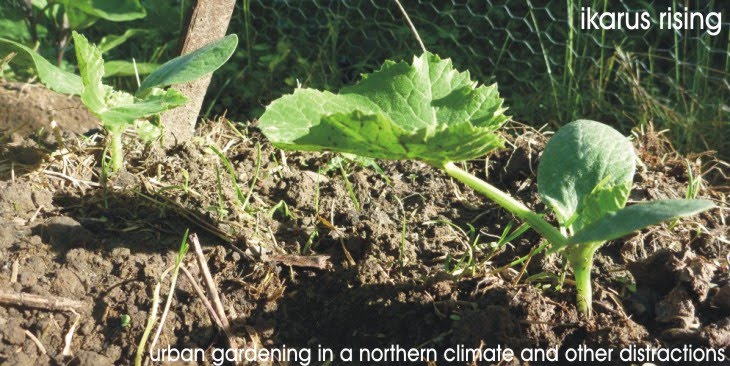Phototropism of the Chadwick cherry tomatoes (tray 1):
My response to this phototropism was to add an extra 2' T5 bulb to each shelf, which was probably fine. My mistake was in increasing the ontime of the fixtures at the same time. The extra light combined with the extra exposure time seems to have primarily affected the tomato seedlings. It's also possible that this was responsible in part for the yellowing of the cilantro leaves, but I think that the brown tips really indicated that they were being overwatered as well. The tomatoes on the second tier slowly started to get yellow, dried out leaves.
Santiam tomatoes with signs of photobleaching (tray 2):
Somehow it didn't occur to me that this yellowing was due to the increased lighting and exposure time. I was distracted by other potential weaknesses of the greenhouse, and thought that they could be the cause. First, I thought that it was the lack of ventilation, and so I cut vents into the plastic sheeting on both shelves and made sure that the plastic sheeting behind the electric heater on the bottom shelf was open a little so that the fan would suck in fresh air when the heater turned on. Then I thought that the tomato seedlings were getting too warm. They still had the seedling heat mat under them heating the soil both day and night, and the lights kept the air and plants quite warm during the day. So, I took another series of temperature measurements over the course of two and a half days (data forthcoming). This confirmed my suspicion that, during the day at least, the air was getting quite warm (in the upper 80s F), and since the heat mat is supposed to raise the soil temperature by 10-20F above the ambient air, this seemed quite warm. Just like with the addition of the vents, however, turning off the heat mat and raising the light fixtures, did not solve the problem of the yellowing leaves.
Around the same time, the leaves on the tomato seedlings on the top tier also started to lose their green color, but instead of just yellowing, they started to look really dry and almost crumbly.
Crumbly, dry leaves on Fox cherry tomatoes (tray 1):
When I finally figured out that it could be photobleaching (which really should've occurred to me much sooner), I switched the light timer back to 15 hours per day and pulled the trays off to the side of the shelves so that they weren't receiving as much direct light. I tried to let them recover in partial shade for a few days before I put them back fully under the lights. This seems to have helped. The green pigment is starting to return to the tomato plants on the second shelf, and most of the tomatoes on the first shelf no longer have crumbly leaves.
Improvement (tray 2):
My current thought is that at best I've just lost a month or so in plant growth, and that they'll eventually recover. I probably need to thin them pretty soon, anyway, and that the stronger plants should hopefully survive. It does seem strange to me that only the tomatoes and the cilantro seem to have been affected. None of the other plants seem to be showing signs of photobleaching.
The worst case is that the plants never really recover and continue to have stagnant growth, never really putting out any more leaves until I finally give up on them. I'm clearly hoping that this isn't the case. I have started a few new Maglia Rosa cherry tomato seeds in the empty slots adjacent to the dill and tarragon in the second shelf tray as a sort of backup plan and to make use of the space that I'm heating and lighting 15 hours a day. These have already started to sprout (quick, even without the heat mat).
Maglia Rosa cherry tomatoes (take two):
The cilantro by the window has also sprouted, though less vigorously than when in the greenhouse.











No comments:
Post a Comment